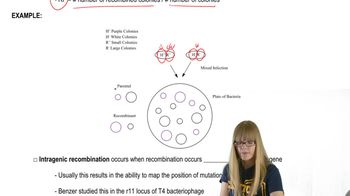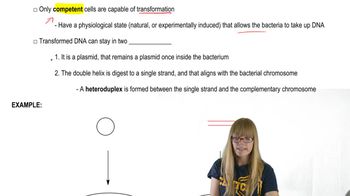Here are the essential concepts you must grasp in order to answer the question correctly.
Bacteriophage
Bacteriophages, or phages, are viruses that specifically infect bacteria. The T2 bacteriophage is composed of a protein coat and DNA, making it an ideal model for studying the genetic material responsible for heredity. Its simple structure allows researchers to easily manipulate and observe the effects of DNA versus protein in genetic transmission.
Recommended video:
DNA vs. Protein Hypothesis
The DNA vs. Protein hypothesis posits that DNA is the genetic material responsible for heredity, while proteins serve primarily structural and functional roles. Hershey and Chase aimed to determine which of these macromolecules carried genetic information. By using T2, they could effectively isolate and test the contributions of DNA and protein to heredity.
Recommended video:
Experimental Design
The experimental design of Hershey and Chase's study involved labeling the DNA and protein components of the T2 phage with radioactive isotopes. This allowed them to track which component entered the bacterial cells during infection. A well-structured experimental design is crucial for drawing valid conclusions about the role of DNA in heredity, as it minimizes confounding variables and enhances the reliability of results.
Recommended video:
 Verified step by step guidance
Verified step by step guidance Verified video answer for a similar problem:
Verified video answer for a similar problem:



 9:32m
9:32m